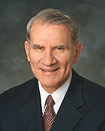The Holy Ghost and Revelation, by Jay E. Jensen
Of the Presidency of the Seventy

When you consider the Holy Ghost, what do you think of? In Sunday School lessons, typical answers may include:
- He is the third member of the Godhead
- He is a spirit; he does not have a physical body
- He is known as the Spirit, or the Spirit of God
- He is a testator of Christ
- He teaches us all things
- He testifies of all truth
I'm grateful for the many roles and duties of the Holy Ghost (read more here), but I was reminded of one of His aspects while reading Elder Jensen's talk:
The Holy Ghost is the third member of the Godhead, and with the Father and the Son, He knows all things (see D&C 35:19; 42:17).
We are familiar with the omniscience of God, but I seem to personally only think of the Father and the Son as being all-knowing—at least at a cursory glance. Perhaps the reason I do this is because the Holy Ghost is often billed as a messenger, and we don't typically think of messengers as knowing all that the message-sender does. Despite this association, the Holy Ghost does know all things.
In addition to knowing all things and acting as a messenger, the Holy Ghost reveals truth. In his talk, Elder Jensen referred to cornerstones of the Church; I really liked this illustration:
President Gordon B. Hinckley called the Book of Mormon one of the four essential cornerstones of the Church, the others being Joseph Smith’s First Vision, the restoration of the priesthood, and of course our testimony of Jesus Christ, the chief cornerstone (see Ephesians 2:19–21). “These four great God-given gifts,” he explained, “are the unshakable cornerstones which anchor The Church of Jesus Christ of Latter-day Saints, as well as the individual testimonies and convictions of its members.”

I'm grateful for the Holy Ghost and revelation. The four cornerstones of my testimony, as illustrated above, are the Book of Mormon, Joseph Smith's First Vision, the restoration of the Priesthood, and my testimony of Jesus Christ, the chief cornerstone.
At the start of his talk, Elder Jensen spoke of the experiences that led him to follow Alma's counsel to "experiment upon the word" (see Alma 32:27-28). This experiment, nourished by faith, leads to the word growing from a seed. We're familiar with this comparison, but I enjoyed the looking back that Elder Jensen alluded to:
These words or seeds have grown into trees, indeed giant trees of testimony. The process continues with more experiments upon the word, resulting in additional trees of testimony, now a veritable forest based on revelation through and by the Holy Ghost.
We may think of the seeds growing, but it's another thing entirely to look back and see the once seedlings as strong, giant trees of testimony.

So, take your pick: nature or structure. Do you prefer the reference to trees or buildings when referencing the testimony that comes from the Holy Ghost and Revelation? It's a difficult decision, but I'm grateful for both!



0 thoughts
Post a Comment